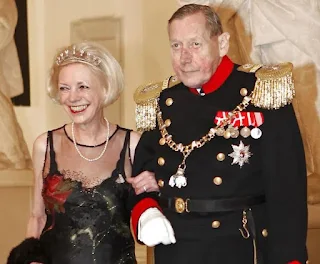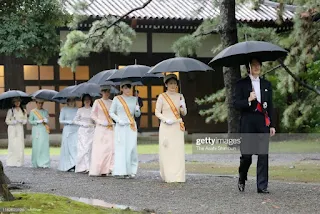The decision of Her Majesty, Queen Margrethe II of Denmark to strip her four grandchildren - Prince Nikolai, Prince Felix, Prince Henrik, and Princess Athena - of their princely status effective January 1, 2023, became the hottest royal news recently.
The Queen, who is now Europe's longest-reigning monarch, defended her decision, saying that its purpose is to streamline the Danish monarchy. Her first cousin, King Carl XVI Gustaf of Sweden, did the same in 2019, but he only removed the Royal Highness styles of his five grandchildren who are not in direct succession to the throne. And retained their prince and princess, along with their duke and duchess, styles.
Queen Margrethe is not the first reigning monarch in the modern world to strip her grandchildren of their princely titles. There were ahead of her who did the same, but for different reasons. And the impact was not as controversial as today in Denmark because the decision was in accordance with the Succession Law of their respective royal houses.
1. Oscar Bernadotte (1859-1953) - He was the second son of King Oscar II of Sweden and the younger brother of King Gustaf V of Sweden. He was also the paternal uncle of Queen Astrid of Belgium and Crown Princess Martha of Norway (mother of King Harald V). His mother was Princess Sophia of Nassau, the sister of Grand Duke Adolphe of Luxembourg.
He was born Prince Oscar of Sweden, Duke of Gotland, but lost his royal titles in 1888 when he married a commoner. He and his wife were created Count and Countess of Wisborg, bearing the name Prince and Princess Bernadotte, in the Luxembourgian nobility, by his uncle, Grand Duke Adolphe of Luxembourg.
2. Count Lennart Bernadotte (1909-2004) - He was the only child of Prince Wilhelm of Sweden (second son of King Gustaf V of Sweden and Princess Victoria of Baden) and Grand Duchess Maria Pavlovna of Russia (eldest child of Grand Paul Alexandrovich of Russia and Princess Alexandra of Greece and Denmark). Lennart's mother was a first cousin of Prince Philip, Duke of Edinburgh.
 |
| Count Lennart Bernadotte of Wisborg and his second wife, Sonja |
He was born Prince Lennart of Sweden, Duke of Smaland. But in 1932, Lennart married a commoner, which was in contravention of the 1809 Instrument of the Government and the 1810 Act of Succession which stated that Swedish royals must seek approval from the monarch when getting married.
He became known as Mr. Lennart Bernadotte, and according to many writeups, was treated cruelly in the Royal Court of Sweden due to his inappropriate marriage. In 1951, Lennart and his first cousins, Sigvard and Carl Johan, who also lost their princely titles for marrying commoners, were admitted by Grand Duchess Charlotte of Luxembourg, their distant cousin, into the Luxembourgian nobility as Counts of Wisborg.
He moved to Mainau island near Lake Constance in Germany, a property inherited by his father from his paternal grandmother. And developed it into one of the most beautiful tourist attractions in Germany.
3. Count Sigvard Bernadotte (1907-2002) - He was born Prince Sigvard of Sweden, Duke of Uppland, and the second son of the future King Gustaf VI Adolf and Princess Margaret of Connaught (granddaughter of Queen Victoria). He was the maternal uncle of Queen Margrethe II of Denmark and the paternal uncle of King Carl Gustaf XVI of Sweden.
Just like his cousin, Prince Lennart, he lost his royal titles and privileges in 1934 when he married a commoner. He was granted the noble title of Count of Wisborg by Grand Duchess Charlotte of Luxembourg in 1951.
Sigvard became a successful industrialist and was known for his designs of luxurious objects including household items. His most iconic designs were the Red Clara opener, the EKA Swede 38 folding knife, the Facit private typewriter, and the Margrethe bowl, which he named after his niece, Queen Margrethe II of Denmark.
For years, Sigvard was known to have fought hard to reinstate his princely title, arguing that his nephew, King Carl XVI Gustaf, also married a non-aristocratic commoner, Silvia Sommerlath, in 1976.
He petitioned for acknowledgment in Sweden of the Prince Bernadotte title. He went to the European Court of Human Rights in an effort to have the Government of Sweden acknowledge his princely title. Before the Court could decide on his case, Sigvard passed away in 2002.
 |
| Count Carl Johan Bernadotte and his second wife, Countess Gunnila |
4. Carl Johan (1916-2012) - He was born Prince Carl Johan of Sweden, Duke of Dalarna, on October 31, 1916, as the youngest son of Princess Margaret of Connaught and the future King Gustaf VI Adolf of Sweden. He was the younger brother of Sigvard Bernadotte.
Just like his older brother, Carl Johan too lost his royal titles and succession rights to the Swedish throne when he married a commoner in 1946.
5. Count Ingolf of Rosenborg (born 1940) - He was born Prince Ingolf of Denmark on February 17, 1940, as the eldest son of Prince Knud, the Hereditary Prince of Denmark, and Princess Caroline-Mathilde of Denmark. He is the first cousin of Queen Margrethe II of Denmark and would have been the King of Denmark today had the Danish Succession Law was not altered in 1953.
 |
| Count Ingolf of Rosenborg and his wife, Sussie |
In 1953, the Danish Parliament altered the Succession Law to male-preference primogeniture succession, which removed Prince Knud from being the Hereditary Prince and made King Frederick IX's eldest daughter, Princess Margrethe, the heir-presumptive.
In 1968, with little hope of ascending the Danish throne, Ingolf did not seek approval from his uncle, King Frederik IX, and from the parliament, when he got married, because he was marrying a commoner and the monarch would surely not approve it. By doing so, he lost his princely title and was created Count of Rosenborg.
6. Count Christian of Rosenborg (1940-2013) - He was the younger brother of Count Ingolf and lost his princely title in 1971 when he did not seek the king's approval when he got married to a commoner.
 |
| Count Christian of Rosenborg and his wife, Anne |
His first cousin, Princess Margrethe, now the Queen of Denmark, also married a non-royal, Henrik Laborde de Monpezat, but was approved by the king due to Henrik family's claim to Count de Monpezat nobility in France.
It was later reported that the nobility status of Queen Margrethe's husband was found to be flawed and inaccurate. Nonetheless, she created Count and Countess de Monpezat noble titles in 2018 to be carried by her descendants in the male line.
7, Other Princes of Denmark who lost their princely status for marrying commoners were Fleming (son of Prince Axel of Denmark), and brothers, Aage, Erik, and Viggo, sons of Prince Valdemar of Denmark and grandsons of King Christian IX. They assumed the title Count of Rosenborg.
8. Daughters of Prince Friso of Orange-Nassau - Prince Friso was the second son of Queen Beatrix of The Netherlands and the younger brother of King Willem-Alexander. When he married Mabel Wisse Smit in April 2004, Prince Friso did not seek the Council of State's approval.
 |
| Prince Friso and Mabel Wisse Smit's wedding in 2004 |
Mabel was accused of "breach of trust" for giving false information about her real relationship with a known drug lord in The Netherlands, Mabel, nonetheless, was granted the title of Princess after the wedding, but cost Prince Friso his place in the line of succession to the Dutch throne.
Though he remained a member of the Dutch royal family, Prince Friso was no longer part of the Dutch Royal House which means that he was no longer in line to succeed. Their children were not bestowed with the princess title. They are known today as Countess Luana and Countess Zaria.
Prince Friso died in August 2013, less than four months after the abdication of his mother and the accession to the throne of his older brother. Prince Friso had been in a coma since February 2012 due to a skiing accident in Austria. He did not regain consciousness until his death in 2013.
9. Children of Prince Constantijn of The Netherlands - He is the younger brother of King Willem-Alexander of The Netherlands and Prince Friso. As such, the youngest son of the former Queen Beatrix.
 |
| Prince Constantijn, Princess Laurentien, and their three children |
Prince Constantijn married Petra Laurentien Brinkhorst, a daughter of a former Dutch cabinet minister, in May 2001. He is currently fourth in the line of succession to the Dutch throne, behind his niece, Princess Arianne.
He has three children, Countess Eloise of Orange-Nassau (born in 2002), Count Claus-Casimir of Orange-Nassau (born in 2004), and Countess Leonore of Orange-Nassau (born in 2006). Though they did not bear a style of prince and princess, they are listed in the line of succession to the Dutch throne.
On May 11, 2001, in an effort to streamline the Dutch royal house, Queen Beatrix released a Royal Decree stating that all children and male-line descendants of her youngest son, Prince Constantjin, would bear the title of Count and Countess of Orange-Nassau and the honorific Jonkheer van Amsberg with the style of His or Her Highborn Lord or Lady and have the surname, van Oranje-Nassau van Amsberg.
10. Japanese imperial princesses - The Chrysanthemum throne of Japan follows the Agnatic Primogeniture Succession which recognizes male heirs only. Their current succession law is governed by the Imperial Household Law of 1947 stating that imperial princesses who will marry commoners will lose their titles and will no longer be part of the imperial family. Most imperial princesses in Japan today became commoners and ceased to be members of the Japanese imperial family.
 |
| Prince Fumihito led the parade of the imperial princesses and former princesses during the enthronement of his older brother, Emperor Naruhito, in 2019. Getty Images |
Princess Yasuko of Japan, the granddaughter of Emperor Taisho, gave up her imperial title and left the Japanese imperial family, as required by law, when she married a commoner, Tadateru Konoe, in 1966. She was reduced to a status of a commoner and became known as Yasuko Konoe.
 |
| Yasuko Konoe former Princess of Japan |
Her younger sister, Masako, also lost her imperial princess title, upon marriage in 1983. Other Japanese imperial princesses who were stripped of their titles for marrying commoners were Noriko and her younger sister, Ayako (daughters of Prince Takamado). Sisters Kazuko and Atsuko (daughters of Emperor Hirohito and sisters of Emperor Akihito) also lost their princess titles upon marrying commoners.
 |
| Yoshiki Kuroda and Princess Sayako on their wedding |
Sayako, Princess Nori (only daughter of Emperor Akihito), followed suit in 2005 when she married Yoshiki Kuroda, a Japanese urban planner. She relinquished her imperial title, along with her state allowance. And left the Japanese imperial family.
Sayako became a high priestess in 2012 at the Ise Grand Shrine, a Shinto shrine in the prefecture of Ise, to assist her aunt Atsuko Ikeda, the Chief Priestess of the shrine.
 |
| Kei Komuro and Princess Mako on the day of their civil wedding |
Princess Mako (eldest daughter of Crown Prince Fumihito) became the recent imperial Japanese princess to lose her title upon marriage to a commoner. Mako's marriage to Kei Komuro in October 2021 received wide media coverage due to the circumstances of their romance.
Their wedding was postponed for more than four years due to a financial controversy involving the mother of Komuro. The issue received backlash from the public. The imperial family of Japan told Komuro to settle the issue to spare the throne from being dragged into the controversy.
Princess Mako was said to have suffered from post-traumatic stress disorder as a result of the controversies sensationalized by the media. As part of the settlement of losing her imperial title, she was offered by the Japanese government of a large sum of money but she refused. Mako and her husband left Japan and moved to New York City after the wedding.












0 Comments